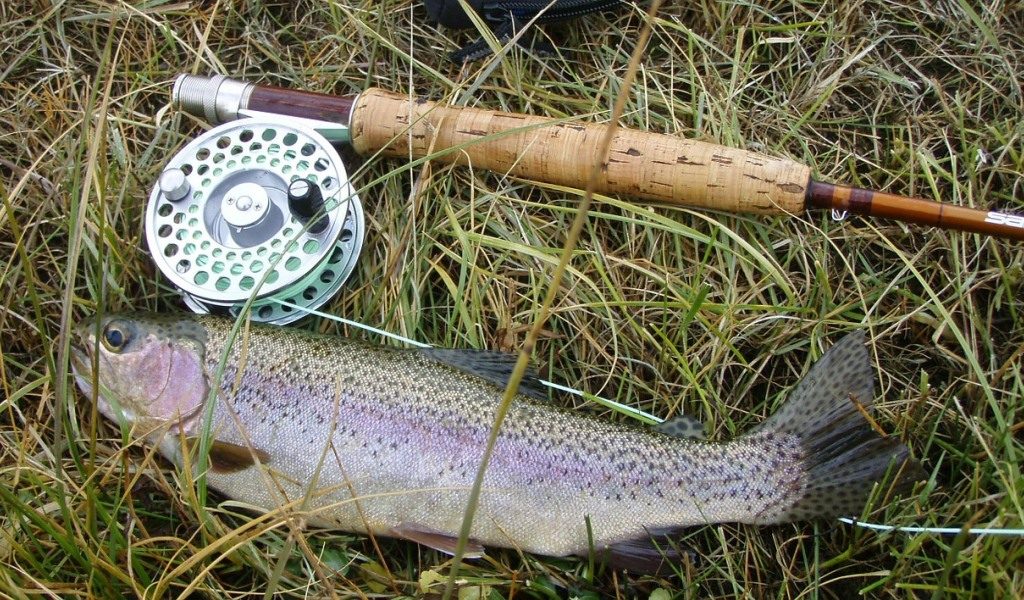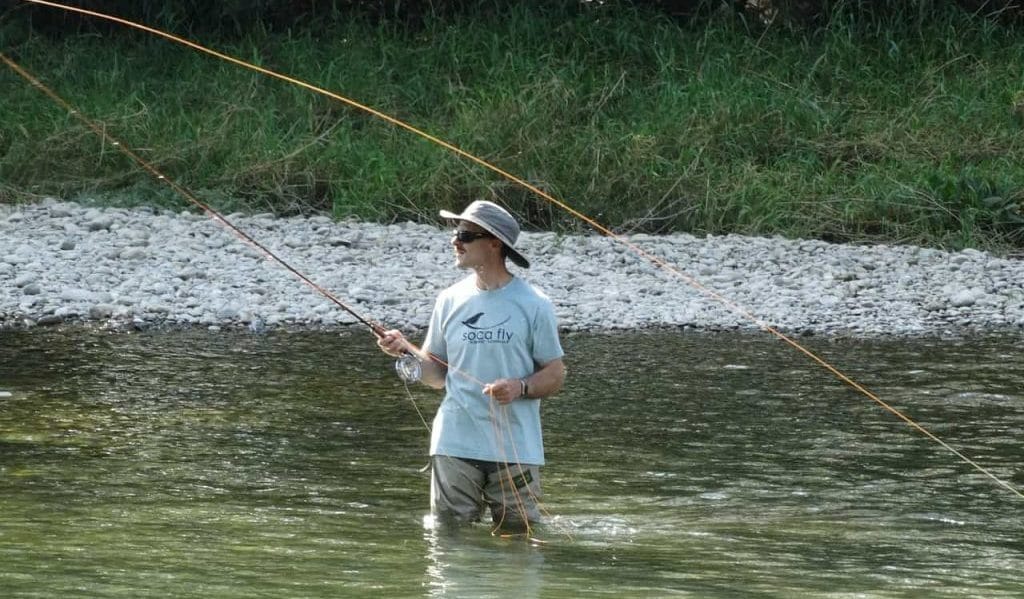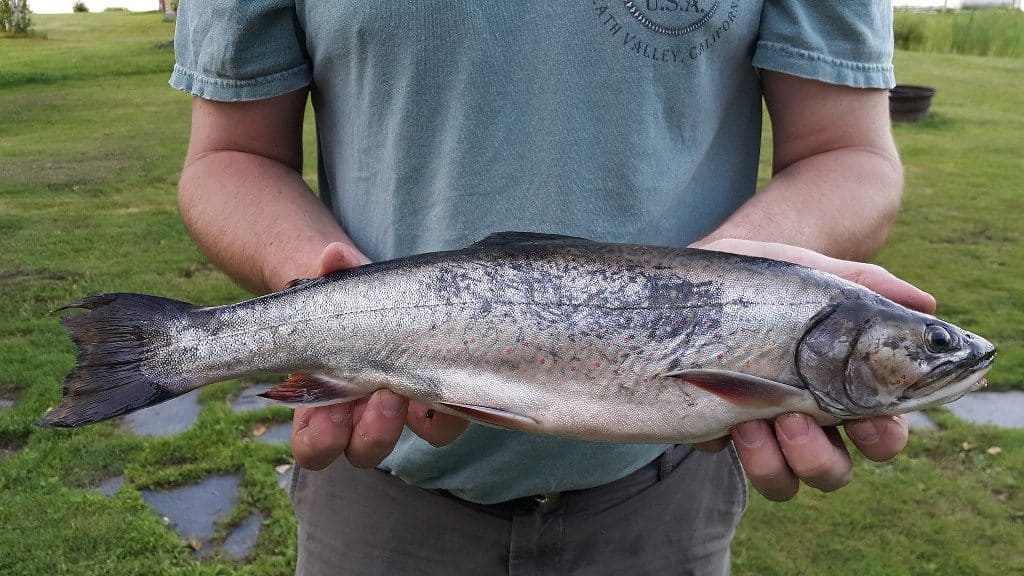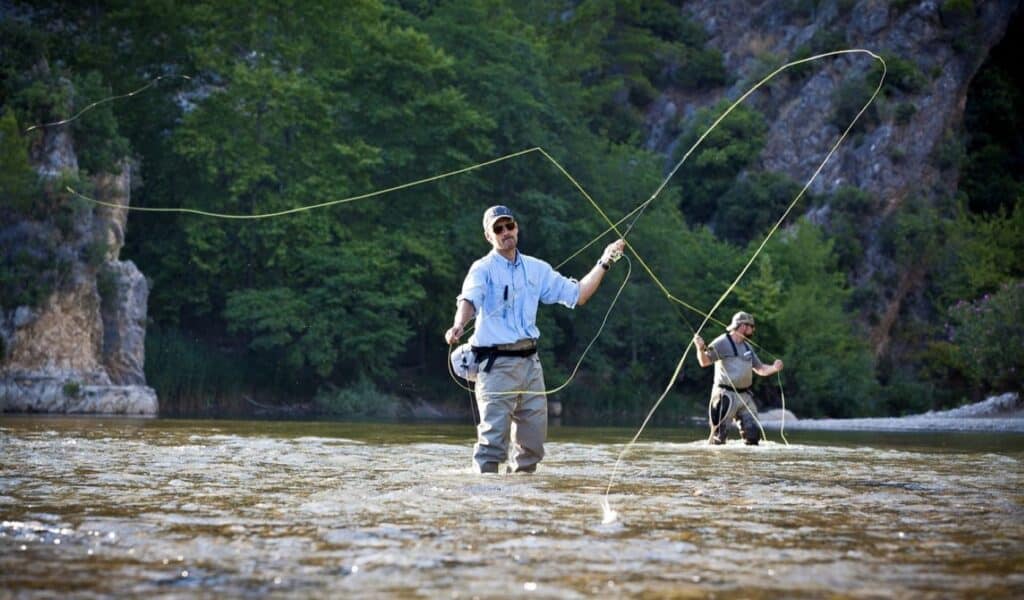Rainbow Trout Fly Fishing Tips: In this guide, we have shared many Rainbow Trout Fly Fishing Tips & Tricks for Beginners! If you are new to fly fishing, we hope this guide can help you learn How to Fly Fish for Rainbow Trout.
In this guide, you will learn:
- What is a Rainbow Trout
- Where to find Rainbow Trout
- What You Beed to Get Started
- Rainbow Trout Fishing Baits
- How to Fly Fish for Rainbow Trout
- Rainbow Trout Fly Fishing Tips
- How to Handle Rainbow Trout
Now, let us now get started.
Rainbow Trout Fly Fishing Tips
Rainbow trout is a popular species among fishermen. People have fly fished for trout for generations on end, so rainbow trout fishing techniques have significantly evolved as fishermen seek the best way to catch them. I will share some useful tips & tricks on how to make your rainbow trout fishing trip successful.
Let me first share some important facts about rainbow trout. You will need this information to fast-track your first catch.
What is a Rainbow Trout
Rainbow trout is a popular game fish that lives mostly in freshwater. It is popular not only with anglers but also at the dinner table. Experts say that it comes 4th in popularity after bass, panfish, and catfish.
Rainbow trout reach up to 12 inches long, and their main diet is smaller fish. A sizeable percentage of their diet consists of subsurface insects and larvae, and they are not as fond of surface vertebrates.
They are the kind of fish that would rather wait for food to come to them instead of hunting for their food. This is possible because of the water current. The rainbow trout is therefore common in rivers with moderate flowing waters.
They are often difficult to see even in clear waters. Their underwater camouflage can indeed be considered perfect. This camouflage helps them to hide from predators like eagles and bears. They are known to live up to 7 years!
Rainbow trout is known for its acrobatic skills that can leave even experienced anglers agape. They can, in fact, make you feel a little sorry for yourself. It is said that they live so long because of their intelligence in escaping predators.
Where to find Rainbow Trout
You will normally find them in the cool waters of streams and lakes. They may spend some time out in the ocean but always return to freshwater to spawn. This migratory behavior gives their body a silvery tint, which is the source of their name.
Their temperament varies with the seasons – the way they take your fly in summer may not be the same in spring.
In summer, look for rainbow trout in holes and deep pools. It is here where they hide in cooler waters while the temperatures near the surface are high.
Rainbow trout spawn in creeks, which they find safe. So If you are fishing in spring, then you should look for the big fish around the creeks. Take note that the fish do not actively feed while spawning. Your bait may not be of interest to them at that time. So you should use big streamers or egg patterns to catch their attention.
Let us now see what specific areas in a river or lake may harbor a large number of trout.
The first place to consider is a local creek. Do not rush into fishing big rivers before learning the basics. Creeks, simply put, are tiny rivers that may have plenty of fish. These are good places to learn and sharpen your rainbow trout fly fishing technique.
While on these creeks, you will have to learn how to read the waters. Try locating any big rock in the creek. You will notice that water moves slowly behind such a rock. There is a high chance that a trout or two are hanging around there. Cast your fly as close to the rock as possible.
The next feature to consider is deep holes; you are likely to find trout here. They love deep pools because of the security they offer and the colder waters present.
Once fish get attached to a kind of habitat, they are likely to stick there for years on end. Therefore, after locating a favorite hole, stay there for an appropriate length of time before moving on. When you break after an extended period without fishing, come back to the same hole and you will find fish.
Another area where water moves slowly in a creek is around a bend. The circular current also means deeper waters, which is a favorite place for rainbow trout.
What You Beed to Get Started
Fly Rod: You’ll need a fly rod suitable for rainbow trout. A 9-foot rod with a 4 or 5wt line is a good choice for most anglers. Make sure the rod is comfortable to hold and easy to use.
Fly Reel: A smooth fly fishing reel with enough drag is important for controlling the fish you hook. But you must match the reel to your rod weight. Load it with line and backing as per spool capacity. You can check our list of the Best Fly Reels Under 100 if you are looking for a quality fly reel on a budget.
Fly Line: A floating fly line is the most versatile choice for rainbow trout fishing. Pick a line that matches the weight of your rod. You may want to try a sinking line if you plan to fish in deeper waters.
Leader and Tippet: A 9-foot tapered leader is a good option for rainbow trout fishing. The leader must match your line weight. You’ll also need tippet material, to tie the end of the leader and the fly. Select a tippet that’s the right size for the flies you’ll be using.
Flies: Rainbow trout feed on a variety of insects, so you may need a selection of flies in your tackle box. Some good choices include dry flies, nymphs, and streamers. Check with any local fly shop on what flies work best in that area.
Waders and Boots: These are essential for staying dry while fishing in streams or rivers. Look for waders that offer enough traction and ankle support. Go for the ones made of breathable material.
Rainbow Trout Fishing Bait
It is important to buy the right bait and lures for rainbow trout as this will increase your chances of hooking up. There is no single bait or lure that is better than the rest. The feeding habit of rainbow trout is varied and you must likewise be dynamic in your approach.
The best one to start with is the live bait. Look at what lives on the shore of the river or lake you are fishing in. This is what is native to the trout in that river or lake and it is an excellent idea to imitate this.
Nightcrawlers, minnows, and crayfish are especially effective in catching rainbow trout. You can also try critters such as grasshoppers, crickets, and beetles. These fall into the river quite often and so rainbow trout are used to feeding on them.
Some of the artificial lures you can use include tubes, spoons, and spinners. Tubes resemble zooplankton. Spoons are normally flashy and tipped with feathers. Their flashiness helps entices the fish to bite.
Spinners are the most popular with anglers. They have flapping blades that add flash to the lure, attracting fish. Swimbaits and worm imitators will also do you good.
Avoid tiny-haired imitators because the trout diet is mostly smaller fish, worms, and shrimp. Power bait is also not a wise choice when it comes to fishing rainbow trout in rivers and lakes. Power bait resembles the pellets that are used to feed stocked trout in hatcheries and farms. Wild trout have no appetite for such pellets.
How to Fly Fish for Rainbow Trout
Fly fishing is one of the most popular rainbow trout fishing techniques. I will now explain step by step how to cast.
- Approach the stream from the downstream end. Make sure to be quiet, so as not to scare the fish away. Scientists say that if you spook a trout, it will forget its need for food and just swim away to protect itself.
- Cast the fly line upstream so that the fly drifts naturally towards you. Keep a steady eye on the line and the fly so that you are aware when the trout strikes.
- The fly should be presented to the trout in the most natural way possible. The problem arises when you cast in holes where the water is slower than that at the point where you are standing. You will tend to move the line faster than the flow of current at the hole. The trout are smart enough to know that this is a fake fly, and will not bite.
- The best approach is to first position yourself on firm ground on the bank of the river or slightly in the river. Hold your fly fishing rod and reel with your thumb on top of the grip. Now raise your forearm, with the rod straight, until the rod is slightly past the vertical position above you.
- Move your wrist back and forth to straighten the line. When it just begins to form a narrow loop, make a forward stroke toward the target. Stop the rod when it is at a 45-degree angle to the ground.
- If you are casting into the wind, it is important to angle your trout fishing rod down during the forward cast. This prevents the wind from catching the line and blowing it back toward you.
Rainbow Trout Fly Fishing Tips for Beginners
Patience and Practice
Fly fishing is a skill that takes time to become an expert in. I often tell enthusiasts to keep an open mind in learning the ins and outs of fly fishing. Give yourself enough time to learn the sport, and it will prove worthwhile in the end.
Time may not allow you to access the stream whenever you want. But this should not keep you from practicing. Ever thought of fly fishing in the parking lot? Or your yard? Try this to improve your casting technique. And when you access the creek, it will save you tons of time for trial and error.
Rainbow Trout Tackle
Being organized is the key to success in trout fishing. What do I mean? Fly fishing for trout requires more energy and concentration than conventional fishing. It is a widespread practice to walk up and down the river banks looking for that prolific spot.
This requires you to have a handy tackle box that you can easily carry along with you. Invest in a good fly fishing rod for this same purpose. Always remember to carry plenty of flies. You do not want to run short of flies midway into the fishing session. You may have many bites before making a catch.
Clothing
Invest in a good pair of drab clothes. Your aim is to keep out of the trout’s sight. Drab clothing will also help you blend with the surroundings, a sort of camouflage for the predator you are. If you are going out on a rainy day, then do not forget to carry a fisherman’s rain suit to help you stay dry.
How to Handle Rainbow Trout
Most fishermen who have just started out do not know exactly how to handle the fish after the catch. It is important to know how to handle the trout. This depends on the intention of your fishing. You may be fishing for fun, where you will need to release the fish back to the water (after a nice photo!), or you may be fishing for food.
Note that trout need to be in oxygen-rich water. Staying out of water for as little as 15 seconds can kill the fish. Do not conclude that the fish has survived if you see it swim away.
When you catch the rainbow trout, keep it in your net and immerse the net in the water. Turn the fish upside down to disorient it- it becomes easier to hold them. When the photographer is ready, hold the trout gently for just a few seconds out of the water. Hold it with one hand just in front of the tail. Do not hold it too tightly as this may tempt it to wiggle away.
If you want to release the fish, you must remove the fly from its mouth. Use a good pair of forceps for this job. Remember to always keep the fish in the water. Once you remove the hook, release the trout preferably into some quieter water. If the fish is bleeding, it is better to keep it because the chances of survival are low.
Take care not to drop the fish onto the bank, especially from a great height. Their survival rate is reduced if they end up flapping on the rocks.
If you intend to keep the fish, it will be good for you to kill them quickly. You do not want to keep them suffering for no reason.
Conclusion
You are now well equipped to go fly fishing for rainbow trout. Here is a five-point summary of how to fly fish for rainbow trout:
- Learn the character and nature of the rainbow trout before going out to fish.
- Have the right equipment for fly fishing. The higher the quality the better, but it should fit into your budget.
- A 4-piece fly rod is easier to carry around. You can check out our pick of the 10 Best Fly Rods Under $200 if you’re looking for a new fly fishing rod.
- Purchase the right bait that matches the natural diet of the rainbow trout.
- Develop the right casting technique. This may require practice and lots of patience.
- Remember to check the necessary laws and permits. These vary from state to state, so it is best to confirm for your specific state.
You can share your rainbow trout fly fishing experience via comments. I will be glad to hear from you.
Last Updated on May 15, 2025 by Blaine Townsend




